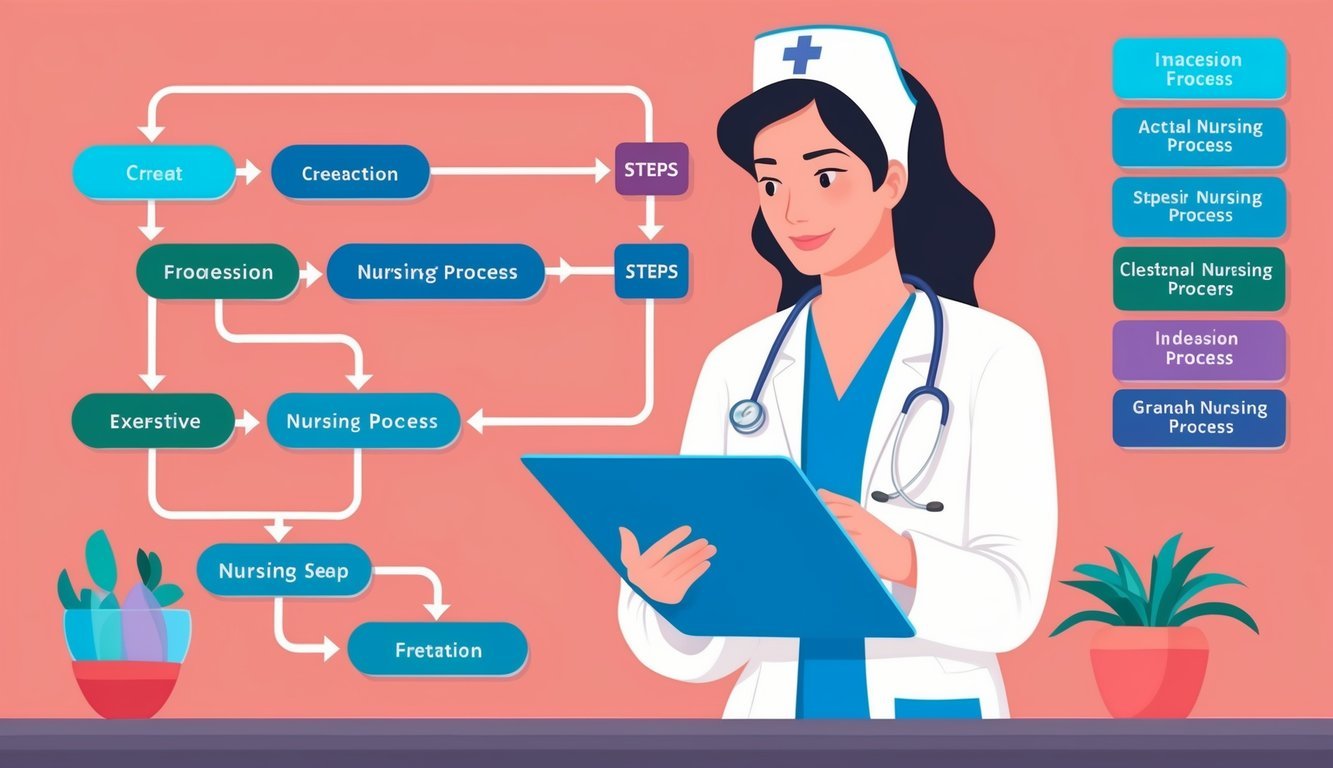The nursing process is essential for delivering high-quality patient care. It consists of systematic steps that guide nurses in assessing, diagnosing, planning, implementing, and evaluating patient outcomes.
Understanding these steps improves your ability to provide effective care and enhances critical thinking skills.
As you learn about the nursing process, you will see how each step builds on the previous one, promoting a structured approach to patient management.
This systematic method is not only evidence-based but also reflects the principles established by nursing theorists like Ida Jean Orlando, who emphasized the importance of nurse-patient interactions.
Engaging with the nursing process helps you connect with your patients on a deeper level while ensuring that their needs are met comprehensively.
By mastering each step, you become better equipped to adapt your care strategies and support your patients’ journeys toward health and wellness.
Key Takeaways
- The nursing process includes five key steps that are essential for effective patient care.
- Each step builds on the last to ensure a comprehensive approach to nursing.
- Understanding this process enhances your skills in critical thinking and patient interaction.
Assessment in Nursing
Assessment is the first and crucial step in the nursing process.
It involves collecting comprehensive information to understand a patient’s health status effectively.
Gathering Objective and Subjective Data
In nursing, you collect both objective and subjective data during the assessment. Objective data includes measurable facts, such as vital signs, lab results, and physical findings.
For example, a blood pressure reading of 120/80 mmHg is objective.
On the other hand, subjective data refers to information shared by the patient, such as their feelings, perceptions, and reported symptoms.
For instance, when a patient states they feel dizzy, it is considered subjective data.
Combining these data types provides a complete picture of the patient’s health.
Using effective communication skills is essential to gather accurate subjective data.
You may use tools like questionnaires or direct interviews to ensure thorough data collection.
Performing Physical Examination and Data Analysis
Conducting a physical examination is key to the assessment process.
You should examine the patient systematically, focusing on different body systems.
A common approach includes inspecting, palpating, percussing, and auscultating to gather physiological data.
Each method provides specific insights into the patient’s health status.
After the examination, you need to analyze the collected data.
Identify any signs and symptoms that align with potential health issues.
Use critical thinking to differentiate between normal findings and abnormalities.
This analysis forms the basis for creating an effective care plan.
Proper documentation is vital during this stage to ensure all information is accurately recorded.
You can refer to guidelines on nursing assessment for further details on these methods.
Nursing Diagnosis
Nursing diagnoses are essential for identifying patient needs and health problems.
They guide the care plan and ensure that nurses address specific issues effectively.
Identifying Health Problems and Needs
To identify health problems, you will begin with a thorough assessment of the patient.
This involves gathering data about their physical, emotional, and social conditions.
You should consider various factors, including:
- Medical history
- Current symptoms
- Lifestyle choices
Use tools such as interviews and physical exams to gather this information.
After collecting the data, analyze it to pinpoint specific health issues.
The goal is to understand how the patient’s needs can affect their overall well-being.
This process is crucial for establishing a clear nursing diagnosis.
Formulating Nursing Diagnoses
Once you identify health problems, it’s time to formulate nursing diagnoses.
This step involves converting assessment data into standardized diagnoses that reflect the patient’s needs.
You will use the NANDA-I (North American Nursing Diagnosis Association International) framework to guide your work.
Nursing diagnoses can be categorized as:
- Actual Diagnoses: These indicate existing health problems.
- Risk Diagnoses: These highlight potential health issues that may develop.
Each diagnosis should be specific and documented clearly.
This clarity helps in planning effective interventions and evaluating outcomes.
You will contribute significantly to the patient’s care plan by accurately formulating nursing diagnoses, ensuring they receive the appropriate support and treatment.
Planning of Nursing Care

Effective planning is essential for providing quality nursing care.
This step involves determining patient needs and setting a clear path for achieving desired health outcomes.
You will create a structured care plan focused on individualized patient care.
Setting Priorities and Outcomes
In this stage, you must prioritize patient needs based on urgency and importance.
Using frameworks like Maslow’s Hierarchy of Needs can help.
For example, addressing basic physiological needs is crucial before tackling higher-level needs such as emotional support.
You will set specific, measurable outcomes for each priority.
These should be realistic and achievable within a defined timeframe.
For instance, if a patient needs pain management, a goal might be to reduce pain levels by 50% within 48 hours.
Documenting these outcomes helps track progress and adjust the care plan as needed.
Developing Nursing Interventions
Once priorities and outcomes are established, you can create nursing interventions to meet those goals.
Each intervention should be evidence-based, aiming to provide the best patient-centered care.
You might use a nursing care plan template to outline interventions clearly.
Examples of interventions include:
- Administering medication
- Educating the patient about their condition
- Coordinating with interdisciplinary team members
It’s essential to individualize these interventions based on the patient’s unique situation.
Regularly reassess the effectiveness of these interventions to ensure they align with the established outcomes and adjust them as needed.
This ongoing evaluation is key to achieving optimal patient care.
Implementation of Care
The implementation phase is crucial in the nursing process.
It involves executing the plan of care to meet patient needs effectively.
Key components include delivering care systematically and working collaboratively with the healthcare team while ensuring proper documentation.
Delivering Systematic Care
In this phase, you provide nursing care based on established protocols and guidelines.
You should follow the care plan while utilizing clinical judgment and evidence-based practice to adapt it to the patient’s needs.
Each intervention should be aimed at promoting health and addressing any issues identified during assessment.
You might perform tasks such as administering medications, monitoring vital signs, and providing education.
Engaging in a therapeutic relationship with the patient helps build trust and improves adherence to the care plan.
Using tools like checklists can help ensure that each step is completed.
This systematic approach promotes quality nursing care and enhances patient outcomes.
Collaboration and Documentation
Collaboration is essential for effective patient care.
You need to communicate with other healthcare professionals, sharing insights and progress updates on the patient’s condition.
This team approach fosters a stronger support system for the patient.
Documentation plays a vital role in this phase.
It’s important to record all interventions, assessments, and patient responses in the electronic health record.
Accurate documentation aids in continuity of care, ensuring that all team members are aware of the patient’s history and progress.
Utilize standardized forms or templates to streamline documentation.
This practice not only improves efficiency but also contributes to quality nursing care.
Clear and concise documentation helps maintain accountability and provides a reference for future care decisions.
Evaluation and Continuity of Care
Evaluation ensures that care delivered aligns with patient needs and goals.
It involves measuring patient outcomes to assess effectiveness and adjusting care plans when necessary.
This process not only supports quality patient care but also enhances patient satisfaction and fosters better health results.
Measuring Patient Outcomes
To effectively evaluate care, you need to measure specific patient outcomes.
These outcomes include physical health indicators, emotional well-being, and functional abilities.
Key Metrics to Consider:
- Vital Signs: Monitor blood pressure, heart rate, and temperature.
- Patient Feedback: Utilize surveys to gauge satisfaction and perception of care.
- Functional Status: Assess mobility and ability to perform daily tasks.
Using evidence-based practices helps ensure that your evaluation methods lead to positive patient outcomes.
Keeping track of patients with comorbid conditions is essential, as these can impact overall recovery.
Regular evaluations help identify any areas needing improvement, supporting better continuity of care.
Adjusting Care Plans for Optimal Health
Your care plan should be dynamic, adapting based on evaluation outcomes.
When patient needs shift, adjusting the care plan becomes vital for optimal health.
Steps to Take:
- Review Data: Analyze outcomes and identify gaps in care.
- Engage Patients: Discuss results with them to understand their goals and concerns.
- Modify Interventions: Adjust treatments or therapies based on the latest data.
Regularly revising care plans not only adheres to patient-centered approaches but also enhances overall patient satisfaction.
This process ensures that patients continue to receive quality care, allowing for successful discharge planning when appropriate.
The goal is to maintain high standards of care and facilitate smooth transitions throughout their healthcare journey.
Frequently Asked Questions

This section addresses common questions about the nursing process steps.
Each question focuses on a specific aspect, providing clear insights into how the nursing process functions in practice.
What are the stages involved in the nursing process?
The nursing process consists of five key stages: assessment, diagnosis, planning, implementation, and evaluation.
Each stage is crucial for delivering effective patient care.
You start with gathering patient information and end with evaluating the outcomes of your interventions.
How do you apply the nursing process in clinical settings?
In clinical settings, you apply the nursing process by first assessing the patient’s needs through observation and data collection.
Then, you create a diagnosis based on your assessment.
You proceed to plan interventions, implement them, and finally evaluate their effectiveness to ensure quality care.
Can you describe the planning phase of the nursing process?
During the planning phase, you set specific and measurable goals for the patient.
You identify nursing interventions that will help achieve these goals.
Collaboration with healthcare team members can enhance the planning process by incorporating different perspectives and expertise.
What methods are used for evaluation in the nursing process?
Evaluation methods include reviewing patient outcomes against established goals.
You may use tools like patient feedback, clinical assessments, and even chart reviews.
Regularly checking progress helps you determine if changes to the care plan are necessary.
In what sequence are the steps of the nursing process typically carried out?
The steps of the nursing process follow a logical sequence: assessment, diagnosis, planning, implementation, and evaluation.
You begin by assessing the patient, then diagnose issues, followed by planning care, implementing the interventions, and finally evaluating their success.
How does the diagnosis phase integrate into the overall nursing process?
The diagnosis phase is vital because it connects assessment data to the planning phase.
In this step, you analyze the information collected during assessment.
This analysis helps identify patient problems, guiding your planned interventions for optimal care.

